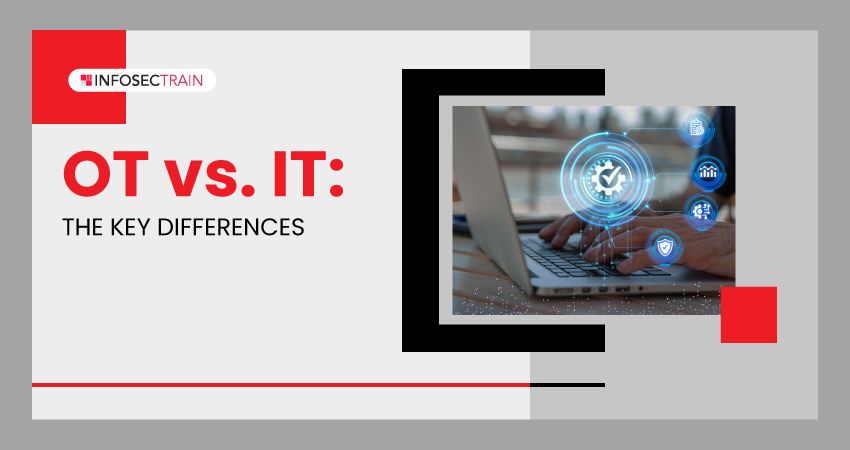Operational Technology vs. Information Technology: The Key Differences
In today’s digitized world, technology plays a pivotal role in almost every aspect of our lives, both personally and professionally. Two crucial domains of technology that often intersect are Operational Technology (OT) and Information Technology (IT). While they serve distinct purposes, understanding the differences and convergence between OT and IT is essential for organizations to ensure seamless operations and cybersecurity. In this article, we explore the contrasting characteristics of OT and IT and delve into their convergence in modern industrial environments.

Table of Contents
Understanding OT (Operational Technology)
Key Characteristics of OT
Understanding IT (Information Technology)
Key Characteristics of IT
Differences Between OT and IT
The Convergence of OT and IT
Understanding OT (Operational Technology)
Operational Technology (OT) refers to the hardware and software systems used to monitor, control, and automate physical processes in various industries such as manufacturing, energy, transportation, and utilities. The primary focus of OT is to manage and optimize industrial operations, ensuring efficiency, safety, and reliability.
Key Characteristics of OT:
- Industrial Environments: OT is prevalent in industrial settings where it controls machinery, sensors, actuators, and other devices.
- Real-time Operations: OT systems are designed for real-time processing, ensuring timely responses to events and data from the field.
- Legacy Systems: Many OT systems have a long lifecycle and may rely on older technologies, making them more challenging to upgrade or secure.
- Safety Critical: In industrial environments, OT often handles critical processes, and any disruptions can have severe consequences.
- Proprietary Protocols: OT devices and networks often use specialized, proprietary protocols for communication.
Understanding IT (Information Technology)
Information Technology (IT) encompasses the hardware, software, and networks used to store, manage, process, and transmit data within an organization. IT focuses on data management, applications, and ensuring the flow of information for decision-making and administrative purposes.
Key Characteristics of IT :
- Business Environments: IT is primarily used in business settings to manage data, support applications, and facilitate communication.
- Data-centric Operations: IT systems are designed to process and store data, enabling business intelligence and analytics.
- Rapid Technological Advancements: IT evolves rapidly, leading to frequent upgrades and updates to hardware and software.
- Internet Protocols: IT networks typically use standardized internet protocols such as TCP/IP for communication.
- Confidentiality and Data Integrity: IT emphasizes data security, confidentiality, and integrity to protect sensitive information.
Differences Between OT and IT :
The primary differences between OT and IT stem from their distinct purposes, environments, and priorities:
| Parameters | OT (Operational Technology) |
IT (Information Technology) |
| Purpose | OT focuses on physical processes and the direct control of industrial operations. | IT revolves around data management, information flow, and supporting business applications. |
| Environments | OT is commonly found in industrial settings, where machinery and physical processes are managed. | IT is used in office environments to support administrative tasks and data processing. |
| Time Sensitivity | OT systems must operate in real-time, with low latency and immediate responses to events. | IT systems may have a higher tolerance for delays. |
| Technology Lifecycle | OT systems often have a longer life cycle, with legacy equipment that can be challenging to upgrade or replace. | IT systems benefit from frequent technological advancements and updates. |
The Convergence of OT and IT :
Over the years, the line between OT and IT has become blurred as industries seek to leverage the advantages of integrating these domains. This convergence, often referred to as IT/OT convergence, has been driven by several factors:
- Connectivity and IoT: The rise of the Internet of Things (IoT) has enabled increased connectivity between devices and systems, allowing data from OT systems to be processed and analyzed by IT infrastructure.
- Data-Driven Decision Making: Integrating OT data with IT systems provides organizations with valuable insights for data-driven decision making, process optimization, and predictive maintenance.
- Cost and Efficiency: Integrating IT and OT infrastructure can lead to cost savings and a surge in operational efficiency through streamlined data sharing and centralized management.
- Cybersecurity Challenges: The convergence also introduces new challenges related to cybersecurity, as the traditionally isolated OT networks become exposed to potential IT-related cyber threats.
Final words:
OT and IT are two critical domains of technology that serve distinct purposes but are increasingly converging in today’s interconnected world. While OT focuses on managing industrial operations in real-time, IT revolves around data management and supporting business applications. Understanding the differences and convergence between OT and IT is essential for organizations seeking to harness the advantages of integration while ensuring the security and reliability of their systems. As the convergence continues to evolve, businesses must adopt comprehensive cybersecurity measures to safeguard their critical infrastructures and data from emerging cyber threats in this interconnected landscape.
Explore the world of OT Security with InfosecTrain’s comprehensive training. Gain insights into securing critical infrastructures and defending against cyber threats. Enroll now for expert guidance!




 1800-843-7890 (India)
1800-843-7890 (India) 
